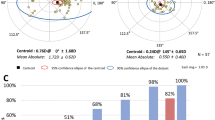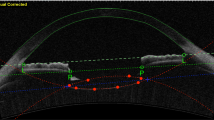Abstract
Objectives
To compare central corneal topography (CT) obtained using the IOLMaster 700® biometer to corneal topography obtained using a Swept-Source OCT-based predicated topographer (PT), in candidates for toric intraocular lens (IOL) implantation.
Methods
A retrospective comparative study was conducted in consecutive patients undergoing a routine cataract surgery assessment with significant astigmatism on keratometry. Each patient was examined using both the IOLMaster 700® (Carl Zeiss Meditec, Jena, Germany) and the Anterion® (Heidelberg Engineering, Heidelberg, Germany) for routine preoperative measurements. The corneal axial anterior power map obtained with each device was then anonymized and analysed independently by two ophthalmologists using a reading grid. The reading grid assessed the usual parameters describing astigmatism and evaluated if a toric IOL was indicated or a second topography examination was needed to confirm the indication.
Results
In total, 169 eyes of 120 patients were included. The inter-examination agreement for the astigmatism description ranged from 56 to 85% depending on the reader and parameter. The decision to implant a toric IOL based on the axial map was the same in 59–60% of cases depending on the examiner. A second examination was needed in 18–25% and 8–14% of cases after CT and PT, respectively. The IOLMaster 700® central anterior axial map allowed toric IOL implantation in 58–70% of cases with no need for second corneal examination.
Conclusion
The agreement between the anterior axial maps obtained using both devices was good. However, in about a quarter of the cases, dedicated topography had to be performed to confirm the surgical indication.
This is a preview of subscription content, access via your institution
Access options
Subscribe to this journal
Receive 18 print issues and online access
$259.00 per year
only $14.39 per issue
Buy this article
- Purchase on Springer Link
- Instant access to full article PDF
Prices may be subject to local taxes which are calculated during checkout

Similar content being viewed by others
Data availability
The datasets generated during and/or analysed during the current study are available from the corresponding author on reasonable request.
References
Ferrer-Blasco T, Montés-Micó R, Peixoto-de-Matos SC, González-Méijome JM, Cerviño A. Prevalence of corneal astigmatism before cataract surgery. J Cataract Refract Surg. 2009;35:70–5.
Yuan X, Song H, Peng G, Hua X, Tang X. Prevalence of corneal astigmatism in patients before cataract surgery in Northern China. J Ophthalmol. 2014;2014:536412.
Hoffmann PC, Hütz WW. Analysis of biometry and prevalence data for corneal astigmatism in 23,239 eyes. J Cataract Refract Surg. 2010;36:1479–85.
Visser N, Bauer NJC, Nuijts RMMA. Toric intraocular lenses: historical overview, patient selection, IOL calculation, surgical techniques, clinical outcomes, and complications. J Cataract Refract Surg. 2013;39:624–37.
Ruiz-Mesa R, Ruiz-Santos M, Blanch-Ruiz J, Jiménez-Nieto A. Acquisition time for swept-source optical biometry plus corneal power measurement during cataract evaluation. Clin Ophthalmol Auckl NZ. 2022;16:661–8.
Wang L, Canedo ALC, Wang Y, Xie KC, Koch DD. Comparison of central topographic maps from a swept-source OCT biometer and a Placido disk-dual Scheimpflug tomographer. J Cataract Refract Surg. 2021;47:482–7.
Rochet E, Levron A, Agard E, Chehab HE, Plas H, Bouvarel H, et al. Should artificial tears be used during the preoperative assessment of toric IOLs before age-related cataract surgery? The TORIDE Study. J Refract Surg Thorofare NJ 1995. 2021;37:759–66.
Montés-Micó R. Evaluation of 6 biometers based on different optical technologies. J Cataract Refract Surg. 2022;48:16–25.
Bullimore MA, Slade S, Yoo P, Otani T. An Evaluation of the IOLMaster 700. Eye Contact Lens Sci Clin Pr. 2019;45:117–23.
Tañá-Rivero P, Aguilar-Córcoles S, Ruiz-Mesa R, Montés-Micó R. Repeatability of whole-cornea measurements using a new swept-source optical coherence tomographer. Eur J Ophthalmol. 2021;31:1709–19.
Cochener B, Cassan A, Omiel L. Prevalence of meibomian gland dysfunction at the time of cataract surgery. J Cataract Refract Surg. 2018;44:144–8.
Trattler WB, Majmudar PA, Donnenfeld ED, McDonald MB, Stonecipher KG, Goldberg DF. The prospective health assessment of cataract patients’ ocular surface (PHACO) study: the effect of dry eye. Clin Ophthalmol Auckl NZ. 2017;11:1423–30.
Author information
Authors and Affiliations
Contributions
RC and CD were responsible for study design. EA, AL, ID, CD, JB were responsible for patient inclusion and data collection. RC and AL were responsible for the interpretation of the examinations. RC was responsible for the statistical analysis. RC drafted the manuscript. CD, JB, EA, ID advised on data analysis and reviewed the manuscript. Each author reviewed the final manuscript and agrees to be responsible for all aspects of the work, ensuring that issues relating to the accuracy or integrity of any part of the work are considered and resolved appropriately.
Corresponding author
Ethics declarations
Competing interests
CD is a consultant for Carl Zeiss Meditec. The remaining authors have no financial or proprietary interest in the materials presented herein.
Additional information
Publisher’s note Springer Nature remains neutral with regard to jurisdictional claims in published maps and institutional affiliations.
Rights and permissions
Springer Nature or its licensor (e.g. a society or other partner) holds exclusive rights to this article under a publishing agreement with the author(s) or other rightsholder(s); author self-archiving of the accepted manuscript version of this article is solely governed by the terms of such publishing agreement and applicable law.
About this article
Cite this article
Chudzinski, R., Levron, A., Agard, E. et al. Comparison of corneal topography maps obtained using the IOLMaster 700® and the Anterion® in candidates for toric IOL implantation. Eye (2024). https://doi.org/10.1038/s41433-024-03094-1
Received:
Revised:
Accepted:
Published:
DOI: https://doi.org/10.1038/s41433-024-03094-1



